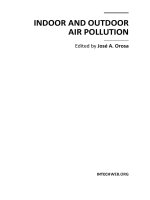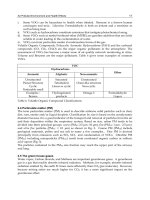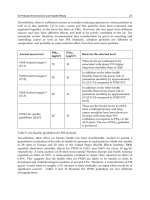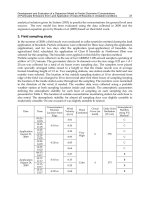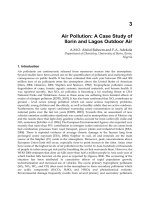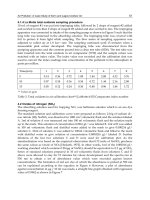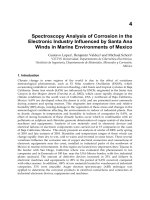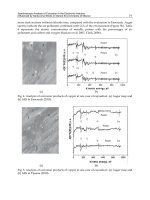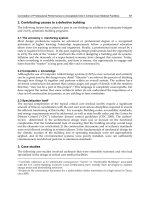Indoor and Outdoor Air Pollution Part 4 pot
Bạn đang xem bản rút gọn của tài liệu. Xem và tải ngay bản đầy đủ của tài liệu tại đây (221.08 KB, 10 trang )
Air Polluted Environment and Health Effects
21
Nevertheless, there is sufficient concern to consider reducing exposure to coarse particles as
well as to fine particles. Up to now, coarse and fine particles have been evaluated and
regulated together, as the focus has been on PM
10
. However, the two types have different
sources and may have different effects, and tend to be poorly correlated in the air. The
systematic review therefore recommended that consideration be given to assessing and
controlling coarse as well as fine PM. Similarly, ultrafine particles are different in
composition, and probably to some extent in effect, from fine and coarse particles.
Annual mean level
PM
10
(μg/m
3
)
PM
2.5
(μg/m
3
)
Basis for the selected level
WHO interim target-1
(IT-1)
70 35
These levels are estimated to be
associated with about 15% higher
long-term mortality than at AQG
WHO interim target-2
(IT-2)
50 25
In addition on the other health
benefits, these levels lower risk of
premature mortality by approximately
6% [2-11%] compared to WHO-IT1
WHO interim target-3
(IT-3)
30 15
In addition on the other health
benefits, these levels lower risk of
premature mortality by approximately
6% [2-11%] compared to WHO-IT2
levels
WHO Air quality
guidelines (QAG)
20 10
These are the lowest levels at which
total, cardiopulmonary and lung
cancer mortality have been shown to
increase with more than 95%
confidence in response to PM
2.5
in the
ACS study. The use of PM
2.5
guideline
is preferred.
Table 9. Air Quality guidelines for PM (annual)
Nevertheless, their effect on human health has been insufficiently studied to permit a
quantitative evaluation of the risks to health of exposure to such particles. Multi-city studies
of 29 cities in Europe and 20 cities in the United States
(Health Effects Institute, 2004)
reported short-term mortality effects for PM10 of 0.62% and 0.46% for every 10 μg/m
3
respectively. A meta-analysis of 29 cities from outside Western Europe and North America
reported an effect of 0.5%. A meta-analysis confined to Asian cities reported an effect of
0.49%. This suggests that the health risks for PM10 are likely to be similar in cities in
developed and underdeveloped countries at around 0.5%. Therefore, a concentration of 150
μg/m
3
would relate to roughly a 5% increase in daily mortality, an impact that would be of
significant concern. Tables 9 and 10 illustrate the WHO guidelines for two different
averaging times.
Indoor and Outdoor Air Pollution
22
24-hour mean level*
PM
10
(μg/m
3
)
PM
2.5
(μg/m
3
)
Basis for the selected level
WHO interim
target-1 (IT-1)
150 75 Based on published risk
WHO interim
target-2 (IT-2)*
100 50
Based on published risk coefficients
from multicentre studies and meta-
analyses (about 2.5% increase in short-
term mortality over AQG
WHO interim
target-3 (IT-3)**
75 37.5
About 1.2% increase in short-term
mortality over AQG
WHO Air quality
guidelines (AQG)
50 25
Based on relation between 24-hour and
annual PM level
Table 10. Air Quality guidelines for PM (24-hr ), *99
th
percentile (3 days/year), ** for
management purpose, based on annual average guideline values; precise number to be
determined on basis of local frequency distribution of daily means
4.5 Health effects due to nitrous oxide (NO
x
)
NO
2
acts mainly as an irritant affecting the mucosa of the eyes, nose, throat, and respiratory
tract. Extremely high-dose exposure (as in a building fire) to NO
2
may result in pulmonary
edema and diffuse lung injury. Continued exposure to high NO
2
levels can contribute to the
development of acute or chronic bronchitis. Low level NO
2
exposure may cause increased
bronchial reactivity in some asthmatics, decreased lung function in patients with chronic
obstructive pulmonary disease and increased risk of respiratory infections, especially in
young children.
Short-Term Long-Term
Effects on pulmonary function, particularly
in asthmatics
Reduction in lung function
Increase in airway allergic inflammatory
reactions
Increased probability of respiratory
symptoms
Increase in hospital admissions
Increase in mortality
Table 11. Health Effects due to NO
x
(Finlayson – Pitts & Pitts 1999)
Guidelines are established as follows (WHO, 2005):
NO
2
concentration: 40 μg/m
3
for annual mean,
and NO
2
concentration: 200 μg/m
3
for 1-hour mean
Effects of NO
2
are more difficult to isolate independently because NO
2
is an important
constituent of combustion-generated air pollution and is highly corelated with other
primary and secondary combustion products. No mortality or illness statistics can be
associated yet based on lack of evidence.
Air Polluted Environment and Health Effects
23
4.6 Health effects due to ozone (O
3
)
Recent epidemiological studies have strengthened the evidence that there are short-term O
3
effects on mortality and respiratory morbidity and provided further information on exposure
response relationships and effect modification. Based on a meta-analysis of studies published
during the period between 1996 and 2001 on short-term effects of O
3
on all non-accidental
causes of death in all ages (or older than 65 years), significant increase of the risk of dying
(between 0.2% and 0.6% per each increase in 10 μg/m
3
) was shown
(
Royal 2007).
The National Morbidity Mortality Air Pollution Study (NMMAPS) study, reported a
significant effect of O
3
during the summer season, of 0.41 % increase in mortality associated
with an increase of 10 ppb (20 μg/m
3
) in daily O
3
“same-day” concentrations. Ozone daily
levels were associated with hospital respiratory admissions at all ages in most of the studies
using 8-hour measures and also in many of the studies using other averaging periods.
The magnitude of the association was slightly larger than that obtained for mortality (0.5 to
0.7% increases in admissions per increase of 10 μg/m
3
in O
3
. Studies on admissions for
asthma in children did not find conclusive associations with any O
3
measurement (Paul
Hawken, et al 1999, Reeves H & Lenoir F.2005). The effects of long-term exposure to Ozone
are much less known. Table 12 provides a summary of health effects related to Ozone. Table
13 presents the WHO guidelines for 8-hr averaging of Ozone concentrations.
Short-Term Long-Term
Adverse effects on pulmonary function Reduction in lung function development
Lung inflammatory reactions
Adverse effects on respiratory symptoms
Increase in medication usage
Increase in hospital admissions
Increase in mortality
Table 12. Health Effects due to O
3
Daily
maximum
8-hour mean
(μ
g
/m
3
)
Effects at the selected ozone level
High level 240
Si
g
nificant health effects, substantial proportion of
vulnerable
p
o
p
ulation affected
WHO interim
target-1 (IT-1)
160
Important health effects, an intermediate tar
g
et for
populations with ozone concentrations above this level.
Does not provide adequate protection of public health.
Rationale:
Lower level of 6.6-hour chamber exposures of healthy
exercising young adults, which show physiological and
inflammatory lung effects.
Ambient level at various summer camp studies showing
effects on health of children
Estimated 3-5% increase in daily mortality* (based on
findin
g
s of dail
y
time-series studies
)
Indoor and Outdoor Air Pollution
24
WHO Air
quality
guidelines
(AQG)
100
This concentration will provide adequate protection of
public health, though some health effects may occur
below this level.
Rationale:
Estimated 1-2% increase in daily mortality* (based on
findings of daily time-series studies)
Extrapolation from chamber and field studies based on
the likelihood that real-life exposure tends to be
repetitive and chamber studies do not study highly
sensitive or clinically compromised subjects, or children
Likelihood that ambient ozone is a marker for related
oxidants
Table 13. Ozone Air Quality guidelines, *Deaths attributable to ozone concentrations above
estimated baseline of 70 μg/m
3
. Based on range of 0.3 to 0.5% increase in daily mortality for
10 μg/m
3
.
5. Indoor air quality
The quality of air inside homes, buildings, schools, day care centers, etc is very important.
The quality of the air that we breathe can have important effects on our health and quality of
life. However, we breathe all time when we are outdoors or indoors. We are used to
thinking of the outdoor environment to be safe from air pollution. It is known that during
smog or dusty air people are advised to stay indoors. Yet new research, in particular
research for the astronauts from the National Aeronautics and Space Administration
(NASA), faced the problem of indoor air pollution and began extensive studies on treating
and recycling air in the chambers. These studies lead to the problem of indoor air pollution.
They discovered that the indoor environment may be as much as ten times more polluted
than the outdoor environment. However, as early as 1950 Dr. T.G. Randolph (Wolverton,
1996) became one of the first medical doctors to link indoor air pollution with allergies and
other chronic diseases. Still today millions of people fail to realize the serious nature of the
problem. Today people living in cities and in industrialized environments spend as much as
80% of their lives indoors fail to recognize this problem. Exposure to indoor air pollutants,
which are many as we will see later, correlates to an increase in the number of allergic
reactions, as well as to chronic diseases due to toxic substances. NASA scientists started to
study the development of sustainable indoor ecological life- support facilities. The NASA
scientists soon discovered that houseplants could purify air in sealed test-chambers. As
many people become concerned about the direct association of indoor environment and
their health, the green revolution will grow. If we stress the importance of indoor air quality
and to relate our existence to a symbiotic and beneficial relationship with the animals and
plants of our nature then we will be closer to our living world.
5.1 House plants and indoor air quality
Evidence is given to show how houseplants can become a necessary component of healthy
buildings whether houses or offices and how houseplants can improve the indoor air
quality. Houseplants are capable of removing toxic chemical vapors. Low relative humidity
levels, below 35 percent are also associated with poor IAQ. Frequent colds and allergic
Air Polluted Environment and Health Effects
25
asthma during the cold winter months are often caused by low relative humidity. Emissions
from modern materials used to construct home or office furniture from pressed wood
products or fiberboard, which often replace natural wood in building construction, as well
as wall- to- wall carpeting are synthetic materials and are held together with glues and
resins. Furthermore, a number of electronic devices are found in our homes today, such as
radios, televisions, etc. for our pleasure are known to emit various organic compounds. The
synthetic materials release hundreds of volatile organic materials (VOCs) into the indoor air.
Compounds that may be found in the air of indoor houses, buildings and offices may be
formaldehyde, xylene, toluene, benzene, chloroform, alcohols, acetone, etc. Humans are also
a source of indoor air pollutants especially in closed and poorly ventilated areas. In addition
to carbon dioxide humans release many volatile substances, in the atmosphere, which are
called “biofluents”, such as, ethyl alcohol, methyl alcohol, acetone, ammonia, etc.
Thus, sealed buildings and synthetic furnishings are the main sources of indoor air pollution
a phenomenon known as “sick building syndrome”(SBS) with some common symptoms, i.e.
allergies, asthma, eye, nose and throat irritation, fatigue, headache, respiratory congestion,
sinus congestion and others. Some also include lung cancer from asbestos exposure.
5.2 Epidimiologic studies
The epidemiological study into symptoms among office workers has produced many
important results, which are conflicting due to methodologic issues in the interpretation of
the epidemiological findings (Mendell, 1993). The environmental factors that were found
increased symptoms with air conditioning, carpets, video display terminals, etc. The
ventilation rates near or below 10 liters/second/person decreased symptoms. Personal
factors, such as female gender, job stress/dissatisfaction and allergies/asthma were also
studied and showed increased symptoms with the above factors. The evidence suggested
that work related symptoms among office workers were relatively common. Indoor
exposure and problems due to this exposure could be reduced if prevention of building
related symptoms may be eliminated with appropriate design, operation and maintenance
practices, such as ventilation rates (Zuraimi, 2010).
In another study microbial indoor air quality and respiratory symptoms of children in schools
with visible moisture and mold problems showed that school buildings of concrete/brick
developed fungi concentration, but not in wooden school buildings (Meklin et al, 2002). There
are more epidemiological studies, which indicate that there are risks associated with elevated
air fine particle concentrations (Mullen et al. 2011, Pope & Dockey, 2006).
Potential health risks may result from environmental exposure to ultrafine particles (< 0.1
μm diameter) in particular exposure in school classrooms. It was found that average indoor
levels were higher when classrooms were occupied than when they were unoccupied due to
ultrafine particle concentrations (Mullen et al. 2011).
A multi location indoor study in air settled dust showed abundance of orthophosphate and
phthalate esters (Bergh et al. 2011). Both groups of chemicals are semi volatile compounds and
they are additives in plastic materials, which are used into indoor environment as industrial
chemicals emanating from furniture in general. These chemicals were found in private homes,
day care centers, and workplaces in the Stockholm area. The phthalate esters were 10 times
higher than the orthophosphate esters. Especially high levels of tributoxyethyl phosphate were
found in the day care centers and high levels of diethylhexyl phthalate in dust.
Indoor and Outdoor Air Pollution
26
6. References
Atkinson, R.W. et al., (2000) Acute Effects of Particulate Air Pollution on Respiratory
Admissions, Am. J. Respir. Crit. Care Med. 164/10, 1860-1866,
Arribas-Monzón, F.; Rabanaque, M.J.; Martos, C.; Abad, J.M.; Alcatá-Nalvaiz, T. & Navarro-
Elipe, M. (2001) Effects of air pollution on daily mortality in Zaragoza, Spain, 1991-
1995, Salud Pública México. Pp.
43 1-8.
Basu R. & Samet J. M. (2002) Relation between Elevated Ambient Temperature and
Mortality: A Review of the Epidemiologic Evidenc,
Epidemiol. Rev., 24(2), 190-202
Bergh, C.; Torgrip, R.; Emenius, G. & Östman, C. (2011). Organophosphate and phthalate
esters in air and settled dust- a multi-location indoor study. Indoor Air; 21; 67-76.
Coull, B.A.; Schwartz, J. & Wand, MP. (2001). respiratory health and air pollution: additive
mixed model analysis,
Biostatistics, 2/3; 337-349
Council on Environmental Quality και
Airport Environmental Handbook, Order 5050.4A,
National Environmental Policy Act (NEPA). Airports Orders.
Dominici, F. (2002) Invited Commentary: Air Pollution and Health –What Can We Leaarn
from a Hierarchical Approach,
Am. J. Epidemiol., 155, , 1-15
Dominici, F. et al, (2007). Particulate Air Pollution and Mortality in the United States : Did
the Risks Change fron 1987 to 2000, Am. J. Epidem., 166 (8), 880-888,
Filliger P., Puybonnieux-Texier V. and Schneider J. (1999). Health costs due to road traffic-
related air pollution. An impact assessment project of Austria, France and
Switzerland. PM10 population exposure. Technical report on air pollution. GVF-
Report nr 326 – TEH05.
Filleul L, Baldi I., Dartigues J F., and Tessier J F., Risk factors among elderly for short term
deaths related to high levels of air pollution,
Occup. Environ. Med., 60(9) 2003, 684-688
Finlayson – Pitts B. J. & Pitts Jr., J. N., (1999). Chemistry of the Upper and Lower
Atmosphere : Theory, Experiments and Applications, Hardcover, Academic Press
Hawken, P.; Lovins, A.B. & Hunter, L. (1999). Natural Capitalism: Creating the Next
Industrial Revolution, Little Brown Company.
Health Effects Institute, 2004, International Oversight Committee, Special reports,
Particulate Matter
Health Canada (2005). Estimated Number of Excess Deaths in Canada due To Air
Pollution”, S. Judek, B. jessiman, D. Stieb, Air Health Effects Division, Health
Canada and R. Vet, Meteorological Service of Canada, Environment Canada, April.
Jerrett M., Burnett R. T., Brook J., Kanaroglou P., Giovis C., Finkelstein N., & Hutchison B.
200. Do socioeconomic characteristics modify the short term association between
air pollution and mortality? Evidence from a zonal time series in Hamilton, Canada
J. Epidemiol, Community Health, 58(1), 31-40
Judek, S.; jessiman, B. ; Stieb, D. & Vet, Health R. (2005). Estimated Number of Excess
Deaths in Canada due To Air Pollution, Air Health Effects Division, Health Canada
Meteorological Service of Canada,
Environment Canada, April.
Katsouyanni, K. (2003). Ambient air pollution and health, British Medical Bulletin,
68 143-156.
Klemm, R. J. ET AL. (2000).Is daily mortality associated specifically with fine particles? Data
reconstruction and replication of analyses. Journal of the air and waste
management association, 50: 1215–1222
Kotzias, D. Human exposure research, Needs and Approaches, 8
th
FECS Conference. 2003, 13.
Air Polluted Environment and Health Effects
27
Kunzli N., Medina S., Kaiser R., Quenel P., Horak F. Jr. & Studnicka M. (2001). Assessment
of Deaths Attributable to Air Pollution: Should We Use Risk Estimates based on
Time Series or on Cohort Studies?
Am. J. Epidemiol., 153, 1050 – 1055
Le Tertre A., Medina S., Samolli E., Forsberg B., Michelozzi P., Boumghar A., Vonk J. M.,
Bellini A., Atkinson R., Ayres J. G., Sunyer J., Schwartz J., and Katsouyanni K.,
Short–term effects of particulate air pollution on cardiovascular diseases in eight
European cities,
J. Epidem. Commun. Health, 56 , 2002, 773-779
Mcdonnell, w.f. et al. (2000). Relationships of mortality with the fine and coarse fractions of
long-term ambient PM10 concentrations in nonsmokers. J Exposure Analysis
Environmental Epidemiology, 10: 427–436.
Meklin, T.; Husman, T.; Vepsäläinen, T.; Vahteristo, M. Koivisto, J.; Halla-Aho, J.;
Hyvärinen, A.; Moschandreas, D. & Nevalainen, A. (2002). Indoor Air. 12; 175-183.
Mendell, M. (1993). Non-specific symptoms in office workers: A review and summary of
epidemiologic literature, Indoor Air. 3; 227-236.
Mullen, N.A.; Bhangar, S.; Hering, S.V.; Kreisberg, N.M. & Nazarof. W.W. (2011). Indoor
Air. Ultrafine particle concentrations and exposures in six elementary school
classrooms in northern California. 21; 77-8
Rita K. Seethaler, K. Künzli N., Sommer H., Chanel O., Herry M5, Masson S., Vernaud J-C.,
Filliger P., Horak F.Jr., Kaiser R., Medina S., Puybonnieux-Texier V., Quénel P.,
Schneider J., Studnicka M., Heldstab J. (2003). Economic costs of air pollution-
related health impacts, An Impact Assessment Project of Austria, France and
Switzerland,
Clean Air & Environmental Quality, Vol. 37, No. 1, 35-43
Reeves H, Lenoir F., Mal de Terre, Editions du Seuil, 2005.
Royal Commission on Environmental Pollution (2007). The Environmental Effects of Civil
Aircraft in Flight. 22 March, Report.
Samet, J.M.; Dominici, F.; Curriero, F.C.; Coursac, I. & Zeger S. L. (2000). Fine particulate air
pollution and mortality in 20 U.S. cities 1987–1994. New Eng J Me., 343: 1742–1749
Samoli E., Touloumi G., Zanobetti A., Le Tertre A., Schindler C., Atkinson R., Vonk J., Rossi
G., Saez M., Rabczenko D., Schwartz J. & Katsouyanni K.(2003) Investigating the
dose-response relation between air pollution and total
total mortality in the
APHEA-2 multicity project,
Occup Environ Med. 60:977-982
Samet J.M. , Zeger, S.L., Dominici F., Curriero F., Coursac I., Dockery D.W. & Schwartz J.,
(2000). The National Morbidity, Mortality, and Air Pollution Study. Part II:
Morbidity and mortality from air pollution in the United States. Health Effects
Institute. North Andover MA: Flagship Press. 94 Part II:1–82.
Schwartz, J. Dockery, D.W., Neas, L.M. (1996). Is daily mortality associated specifically with
fine particles? Journal of the air and waste management association, 46: 927–939
Schwartz, J. & Neas L. M. (2000) Fine particles are more strongly associated than coarse
particles with acute respiratory health effects in schoolchildren. Epidemiology, 11:
6–10
Sommer, H., Seethaler, R., Chanel, O., Herry, M., Masson, S., Vergnaud, J C. (1999). Health
costs due to road traffic-related air pollution. An impact assessment project of
Austria, France and Switzerland. Economic evaluation. Technical report on
economy. GVF-Report nr 326 – TEH07 Federal Department for Environment,
Transport, Energy and Communications Bureau for Transport Studies, Bern.
Indoor and Outdoor Air Pollution
28
Prepared for the Third World Health Organisation Ministerial Conference of
Environment and Health
, London, 1999.
Sunyer J. and Basagana X., Particles, and not gases, are associated with the risk of death in
patients with chronic obstructive pulmonary disease,
Int. J. Epidemiol., 30, 2001;
1138-1140
Theophanides, M.; Anastassopoulou, J. & Theophanides, T. (2002). A statistical study of
disease-related mortalities due to environmental pollutants in Kavala, Greece, In
Environmental science and pollution research, 8
th
FECS Conference on chemistry
and the environment, 44.
Theophanides, T.; Vassilakos, Ch.; Anastassopoulou, J.; Maggos, T.; Hatzianestis, J &
Bartzis, I. (2002). Chemical Characterization of VOCs in Nea Karvali area, Kavala,
Greece, In
Envirommental science and pollution research, 8
th
FECS Conference on
chemistry and the environment
, 45-46.
Theophanides, M.; Anastassopoulou, J.; Vasilakos, Ch.; Maggos, Th. & Theophanides, T.
(2007). Mortality and Pollution in Several Greek Cities, J. Envir. Scien Health, Part
A, 42/6; 741-746.
Theophanides, M. & Theophanides, T. Human environmental engineering and
sustainability, in M. Theophanides and T. Theophanides Eds., Environmental
Engineering and Economics, ATINER, Athens, Greece, pp. 1-8.
Theophanides, M. & Anastassopoulou, J. (2009). Simulation of Air Pollution and Health
Effects, In: in
Environmental Awarness and Management, eds, T. Theophanides and M.
Theophanides, ATINER, Athens, Greece, pp. 29-37
Touloumi, G.; Pocock, SJ.; Katsouyianni, K. & Trichopoulos, D. Short-term effects of air
pollutions on daily mortality in Athens: a time- series analysis, Int. J. Epidemiol.
1994,
23 957-967.
The MACBETH project (1999): Monitoring of atmospheric concentrations of benzene in
European towns and homes,
EU LIFE project 96ENV/IT070
Tunnicliffe W. S., Harrison R.M., Kelly F. J., Dunster C., and Ayres J. G., The effect of
sulfurous air pollutant exposures on symptoms, lung function, exhaled nitric oxide,
and nasal epithelial lining fluid antioxidant concentrations in normal and asthmatic
adults,
Occup. Environ. Med. 60(11), 2003, 15-15
Tobias, A.; Saez, M.; Daniels, M. J,; Dominici, F.; Zeger S. L. & Samet J. M., RE (2001).
Estimating Particulate Matter – Mortality Dose – Response Curves And Threshold
Levels: An Analysis Of Daily Time – Series For The 20 Largest Us Cities,
Am. J.
Epidemiol., 153, 1027 – 1028
WHO (2002). Systematic review of health aspects of AQ Europe. An overview of the St.
George’s project. A systematic review of the epidemiological literature on the short-
term health effects of outdoor air pollution, St. George’s Hospital, London, United
Kingdom.
Wolverton, B.C. (1996).How to Grow Fresh Air: Houseplants that purify your home or
office, Penguin Books.
Yang, C-Y.; Chang, C-C.; Chuang, H-Y.; Tsai, S-S.; Wu, T-N.; Ho, C-K. Relationship between
air pollution and daily mortality in a subtropical city: Taipei, Taiwan, Environm.
Int. 2004,
30 519-523.
Zuraimi, M. (20101). Is ventilation dust useful? A review of scientific evidence. Indoor Air.
20; 445-457.
2
Development and Evaluation of a Dispersion
Model to Predict Downwind Concentrations of
Particulate Emissions from Land Application of
Class B Biosolids in Unstable Conditions
Abhishek Bhat, Ashok Kumar and Kevin Czajkowski
1
Department of Civil Engineering, The University of Toledo, Toledo,
1
Department of Geography and Planning,
The University of Toledo, Toledo,
USA
1. Introduction
The term, biosolids, is generally used to refer to those waste products that have been
stabilized by treatment of the sewage sludge for beneficial reuse through appropriate
management (Davis, 2002). The agronomic and environmental benefits from the organic
material and fertilizing elements contained in the biosolids are essential for maintaining soil
fertility. This has been a major reason for the application of biosolids on the agricultural
fields. These biosolids reused for land application on agricultural fields has potential
benefits. Davis (2002) in his study described the following benefits:
1. The land application of biosolids is mainly used to improve the soil quality. The organic
matter from the soil can be built. Water retention, soil stabilization, and reduced soil
erosion are some of the other benefits.
2. Applied biosolids can partially or completely substitute commercial fertilizer. These
biosolids contain nutrients present in conventional fertilizer including nitrogen,
phosphate, and other additive elements.
3. The application of biosolids or reuse of biosolids reduces the quantity of waste required
to be disposed in landfills. This reduces the pollution due to landfills, leachates, etc.
The process of land application of biosolids on agricultural land has been carried out for
generations. The agricultural activities related to the land application of biosolids aerosolize
particulate matter. The United States Environmental Protection Agency (US EPA) regulates
particulate matter as a “criteria pollutant”. The particulate matter emitted during various
agricultural activities impact air quality. The particulate matter generated from agricultural
activities includes dust from the fields and dust generated from agricultural activities. The
particulate matter emitted from the agricultural activities can contain bioaerosols,
endotoxins, and pathogens. The airborne particles consisting of or originating from the
microorganism are called bioaerosols. Bioaerosols containing pathogenic bacteria and
harmful microorganisms accompanied with handling and the application process could
harm the public health and environment. Modeling transport and dispersion of the
Indoor and Outdoor Air Pollution
30
particulate matter emitted during the land application of biosolids is important to predict
the downwind concentrations and in turn to predict the risk.
The objective of this chapter is to model the particulate matter released during and after the
application of biosolids based on the data collected during the field study. The efforts
include a derivation of solution to the convective-diffusion equation incorporating wind
shear.
2. Literature review
Emissions of particulate matter during the application of these biosolids were studied by
various researchers. Paez-Rubio et al. (2006) studied the composition of these particulate
matters and determined the emission rates due to disking activity. The researchers used
arrayed samplers to estimate the vertical source aerosol concentration, which were used to
calculate the plume. The different constituents of the biosolids and their emission rates were
reported in the study.
Brooks et al. (2005) derived an empirical equation to estimate the bioaerosols risk infection
to residents adjacent to the land that is applied with biosolids. For this study, a coliphage
MS-2 and Escherichia coli organisms were aerosolized after adding them to water within a
biosolids spray application truck. Then the downwind concentration of these
microorganisms was measured at various distances ranging from 2 m to 70 m. The data
were taken downwind of the sprayer and were used to derive an empirical equation. The
limitation of this study is that the authors used a simplistic regression model to determine
the transport. US EPA’s SCREEN 3 dispersion model was used to predict the downwind
concentrations of particulate aerosols in the study by Taha et al. (2005). The emission rates in
this study were determined by the wind tunnel experiments conducted on the surface of the
static compost windrows. In a similar study, Dowd et al. (2000) predicted the downwind
concentration of airborne viruses from a biosolids placement site. The study incorporated a
modified Gaussian equation to quantify the downwind concentrations in an area
undergoing the land application of biosolids. The model was used to predict the downwind
concentration of microorganisms from an area source by taking into account the length and
the width of the agricultural field.
A major difference between a conventional source of particulate matter and an agricultural
source is that the later is a ground level source. Conventionally the wind velocity used in the
downwind concentration calculated by researchers was used as an average velocity which
was assumed to be constant over the vertical stretch of the plume. In real conditions, near
the ground level, the magnitude of velocity changes with the change in vertical height. A
vertical shear layer is formed and the velocity varies at a rapid rate near the ground. Thus
the concentrations predicted can show large variations if the wind shear is not taken into
account during dispersion. Kumar and Bhat (2008) discuss a possible generic model for
transport and dispersion of particulate matters incorporating wind shear (magnitude shear
only) near the ground. There is a need to understand and apply the knowledge of dispersion
modeling to particulate fate and transport. It is important to develop a general screening
model to predict downwind concentrations. The account for wind shear near the ground
needs to be studied and incorporated in the existing models. The book entitled
“Micrometeorology” by Sutton (1953) gives a solution using the variable eddy diffusivity
and wind speed for steady state two-dimensional convective-diffusion equation
representing the diffusion from an infinite line source. Kumar and Bhat (2008) extended the
